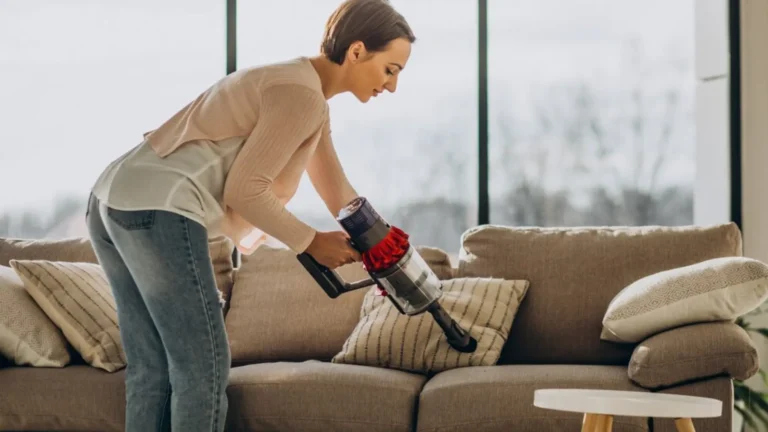How To Dry Clean Your Sofa At Home
Did you know that the average cost of professional sofa cleaning can range from, depending on the size and material? That’s quite the chunk of change that could be better spent on literally anything else.
But here’s the kicker: With just a few household staples like baking soda, vinegar, and some elbow grease, you can achieve the same dazzling results for a fraction of the cost. In fact, by following our simple guide, you could save up to 90% of what you would typically pay professionals. That’s right, 90%!
We’re here to guide you step by step through a straightforward process that will make you wonder what you ever considered hiring out. We’ll share insider tips on how to keep your sofa looking its best day in and day out, ensuring that your living space remains welcoming and comfortable.
Plus, we’ll throw in some easy maintenance tricks that will prolong the freshness of your sofa, keeping it the centrepiece of your home without draining your bank account.
So, are you ready to transform your sofa from blah to wow, impress your guests, and pat yourself on the back for being such a savvy saver? Let’s dive in and make your sofa sparkle without the hefty price tag!
Why Dry Clean Your Sofa at Home?
There is increasing demand for sofa cleaning services in Manchester. This shows that most understand the need for regular sofa maintenance, but the price of professional cleaning prevents most, which ranges from £50 to £200 depending on the size and material.
Dry cleaning of your sofa at home is an excellent solution to that ‘holy’ war between cleanliness and money. And that is why:
- Cost: you’ll be charged around £100 by a professional, whereas this can be managed free of cost while sitting at your place for just £10 on materials
- Time: you can do it at your leisure without waiting in line for a booking
- Safe: there’s no risk of allergy or damage to the fabric as dry cleaning is done safely from home.
How to Dry Clean Your Sofa at Home?
Step 1. Check the Fabric Care Label
Before you begin cleaning, inspect the fabric care label on your sofa. Generally, most sofas will be labelled with a code to ensure you know which cleaning method is safest to use:
- W – Water-based cleaners are safe
- S – Only solvent-based cleaners are safe
- W/S – Either water-based or solvent-based cleaners
- X – Vacuum-only cleaning: avoid any liquid cleaners
Knowing this will prevent you from using products that may damage your upholstery. Assuming your sofa is marked “S” or “W/S,” it can easily be home-dry cleaned with no fuss.
Step 2: Gather Your Gear
To dry clean your sofa, you will need:
- Vacuum cleaner with upholstery attachment
- Baking soda
- White vinegar
- Dry cleaning solvent for solvent-only fabrics
- Soft-bristled brush
- Microfiber cloths
These are available and, in most instances, are at your home. For example, a bottle of dry cleaning solvent can cost as low as £5 to £15.
Step 3: Vacuum the Sofa
Vacuum up the top surface of your sofa, including crevices where dust and crumbs collect. This evacuates loose dirt and prevents it from embedding into the fabric further while it’s being cleaned.
A clean survey from the American Cleaning Institute reports that regular upholstery vacuuming eliminates around 80% of dirt and allergens.
Step 4: Application of Baking Soda
Baking Soda is a natural deodoriser that can absorb smells and oils from your sofa. Sprinkle it liberally on the fabric, and let it stay there for at least 15 to 20 minutes. For more robust stains or odours, you may leave them overnight.
Not just deodorising but also cracking oils and grime, it saves you up to £20 for professional deodorising services.
Step 5: Brush and Spot Clean
Work with a soft-bristled brush to work the baking soda well into the fabric without causing damage to the material. They are brushed, vacuum once again to remove the leftover baking soda.
For more challenging spots, you may use this homemade cleaner:
- Mix equal parts of white vinegar with water in a spray bottle.
- Spray them lightly on the stain and blot it gently with a microfiber cloth.
- For fabrics coded “S, use a dry cleaning solvent instead of vinegar for the solution.
Vinegar-based solutions kill bacteria 99%; hence, they is an excellent natural substitute for chemicals. This costs less than one pound for a bottle as well.
Step 6: Let It Air Dry
After spot cleaning, let your sofa dry in open air completely. This would be essential since moist residues can lead to mold growth, which is not so healthy for your sofa or you. You can place a fan next to your sofa to dry faster.
More Tips for Your Sofa
So, now that your sofa is clean, here are some even more simple tips to keep it fresh for a long time:
- Vacuum weekly: Prevent dirt from penetrating deeply into the fabric
- Rotate cushions: This way, wear is evenly distributed and indentations do not occur
- Sofa covers use: Sofa covers help protect your upholstery from spills and dirt, thereby extending its life to up to 50%
- Treat stains immediately: The longer a stain is left to drench the fabric, the harder it becomes to remove. You can have a spray bottle of your vinegar solution at hand for quick cleanups.
Final Thoughts
DIY sofa cleaning costs about 90% less than hiring professionals to do the job. This can translate to many savings for larger households or people who own multiple sofas.
The real payback of doing this in your home is that you do not have to throw down huge sums at the local dry cleaner. It saves hundreds of pounds every year, and you get to extend the life of your sofa by a considerable amount as well. You can keep your space fresh and inviting with just a few common items in your household and some effort.
The next time you think of hiring a professional cleaner, you might want to consider the alternative – and that is getting it done by yourself. You’d be surprised at how easy it was to get great results without spending too much money!



